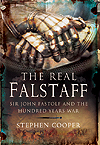
The Real Falstaff: Sir John Fastolf and the Hundred Years’ War, by Stephen Cooper, Pen and Sword Books, Barnsley, United Kingdom, 2011, $39.95
In his play Henry VI, Part I, William Shakespeare depicted “Sir John Fastolfe” at the 1429 Battle of Patay as a coward and a liar, in dramatic opposition to the nobler Sir John Talbot, Earl of Shrewsbury. The “Falstaff” character also appears in Henry IV, as a fat drunkard and ruffian, and again, even more farcically, in The Merry Wives of Windsor. But the real-life inspiration for those characters, Sir John Fastolf (circa 1380–1459), was neither fictional nor farcical.
In The Real Falstaff, Stephen Cooper explores the man behind the mischaracterization. Fastolf was born in Caister Hall, Norfolk, and began his military career alongside Henry Bolingbroke, the future King Henry IV. Failing to join Bolingbroke on a crusade against Lithuania with the Teutonic Knights, he did join the future king on a pilgrimage to Jerusalem. Fastolf first experienced combat in Ireland under Bolingbroke’s son Thomas of Lancaster, Duke of Clarence, but his moment of martial glory came in the much-disputed French provinces of Normandy, Maine and Aquitaine.
Though described by one of his servants as a man “for the most part without pity or mercy,” Fastolf was known to be a man of letters; he helped found a university in Caen in 1431. He was also an avid book collector, owning at least 25 volumes at the time of his death—each a hand-scribed manuscript worth the equivalent of a medium-sized farm. And he was a benefactor of Magdalen College in Oxford. In sum, Fastolf the adventurer and scholar seems a model English gentleman for his time. Cooper’s scholarship has restored a personality fascinating in his own right and diametrically opposed to the infamous characters earlier portrayed on stage.
—Thomas Zacharis




